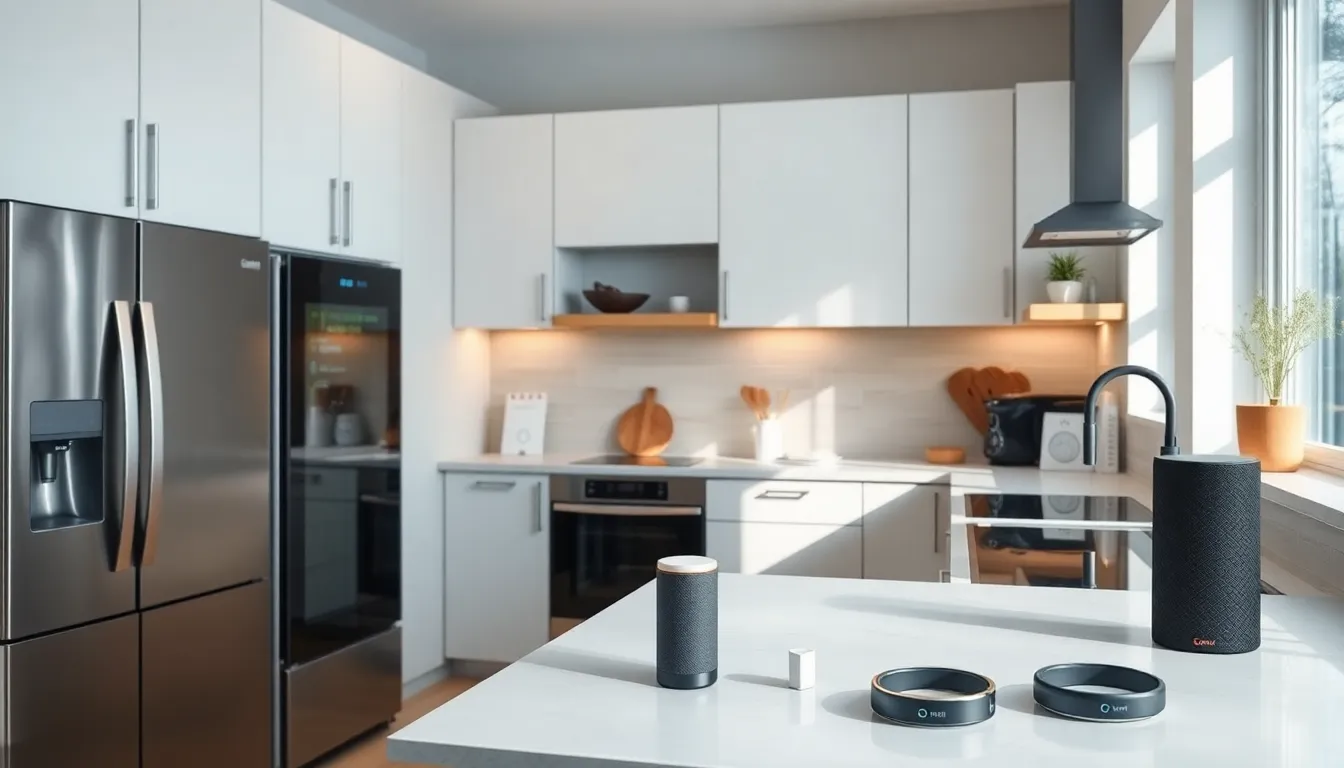In a world where your fridge can remind you to pick up milk and your thermostat knows when you’re too hot to handle, consumer IoT is revolutionizing everyday life. Imagine a home that anticipates your needs, making life smoother than a freshly brewed cup of coffee. With smart devices popping up everywhere, it’s hard to ignore the charm of a connected lifestyle.
Table of Contents
ToggleOverview of Consumer IoT
Consumer IoT refers to a network of interconnected devices that enhance everyday living through smart technology. Smart gadgets create a seamless interaction between users and their environment.
Definition and Concepts
Consumer IoT encompasses devices connected to the internet that enable communication and data exchange. Common examples include smart home appliances, wearables, and home automation systems. These devices gather data to improve efficiency and usability in various applications. Examples of consumer IoT include smart refrigerators that track inventory and fitness trackers that monitor health metrics. Collectively, they contribute to a more integrated lifestyle by promoting automation and convenience.
Importance in Modern Life
Consumer IoT significantly impacts daily routines by simplifying tasks. Individuals enjoy enhanced convenience through interconnected devices that adhere to personalized preferences. Smart thermostats optimize energy consumption by learning user patterns, resulting in cost savings. Integration with smartphones facilitates remote control of devices, providing users with flexibility and control. Enhanced safety features, such as smoke detectors that send alerts to mobile phones, showcase consumer IoT’s role in enhancing security. Overall, these advancements increase quality of life by promoting efficiency and connectivity.
Key Components of Consumer IoT

Consumer IoT consists of several critical components that create an interconnected and efficient living environment. Understanding these components helps appreciate how smart technology enhances everyday life.
Devices and Gadgets
Smart home appliances play a central role in consumer IoT. Examples include refrigerators that track grocery inventories and ovens that can preheat remotely. Wearables, such as fitness trackers and smartwatches, monitor health metrics, providing users with valuable insights into personal health data. Home security systems feature cameras and smart locks, enhancing safety through remote monitoring and alerts. Sound systems and smart speakers integrate seamlessly, allowing users to control music and access information using voice commands. Together, these devices improve convenience and comfort for many households.
Connectivity Solutions
Wireless communication technologies form the backbone of consumer IoT. Wi-Fi networks connect smart devices, enabling data exchange and remote access. Bluetooth allows easy pairing and communication between gadgets like smartphones and wearables, creating effortless interactions. Zigbee and Z-Wave offer low-power alternatives for smart home devices, optimizing energy consumption while maintaining reliable connectivity. Additionally, mobile networks support remote access, allowing users to control devices away from home. These connectivity solutions ensure that a wide range of consumer IoT devices work together to create a cohesive and user-friendly experience.
Benefits of Consumer IoT
Consumer IoT offers significant advantages in everyday life, enhancing convenience and improving user experiences.
Convenience and Efficiency
Smart devices streamline daily tasks, allowing individuals to manage chores with minimal effort. For example, automatic grocery lists generated by refrigerators prevent running out of essential items. Smart thermostats optimize energy usage based on personal preferences, saving money on utility bills. Users can adjust home settings remotely on their smartphones, enabling effortless management of appliances. Automation also reduces time spent on mundane tasks, making routines more efficient. Data analysis from wearables helps track fitness goals without constant manual input. Enhanced connectivity among devices ensures that everything operates seamlessly, contributing to a harmonious living environment.
Enhanced User Experience
Personalization elevates user interactions with technology. Smart home systems adapt to lifestyles, learning preferences over time. For instance, lighting and climate can adjust automatically based on occupancy and time of day. Safety features, such as security cameras with real-time notifications, offer peace of mind that enhances overall living quality. Voice-activated assistants simplify daily operations, allowing for hands-free control of devices. Devices that communicate through unified platforms foster a more integrated home experience. The seamless exchange of data ensures that devices collaborate effectively, further enhancing the user experience.
Challenges and Concerns
Consumer IoT faces significant challenges and concerns that users must address.
Security Issues
Security represents a critical concern for consumer IoT. Devices often connect to home networks, making them vulnerable to hacking. Attackers can exploit weak passwords or outdated firmware to gain unauthorized access. Such breaches can lead to unauthorized control of smart devices, creating safety risks. A study by Symantec shows that vulnerabilities in connected devices increased by 300% from 2017 to 2020. Consequently, manufacturers need to prioritize security measures during device development. Regular updates and robust encryption can mitigate risks while protecting user data. Users must also adopt strong, unique passwords and enable two-factor authentication when possible.
Data Privacy
Data privacy emerges as a pressing issue within the consumer IoT landscape. Devices continuously collect personal information, such as usage patterns and preferences. This data, while valuable for enhancing user experience, raises privacy concerns. In 2021, the Pew Research Center found that 81% of Americans feel that the potential risks of sharing personal data outweigh the benefits. Companies often share this information with third parties for marketing purposes, leading to further privacy implications. Users remain at risk of data misuse if proper safeguards are not in place. Therefore, adopting transparent data practices and obtaining user consent is crucial for responsible data management.
Future Trends in Consumer IoT
Consumer IoT continues to evolve rapidly, driven by technological innovations and market dynamics.
Technological Advancements
Artificial intelligence increasingly enhances smart devices, allowing them to learn user preferences over time. Voice recognition improves, enabling more intuitive interactions with smart assistants. Edge computing facilitates faster data processing and reduces latency, leading to quicker response times in connected devices. Integration of augmented reality within IoT applications provides users with immersive experiences, like virtual appliance setups. Robust protocols such as Matter streamline compatibility between devices, promoting a seamless user experience. These advancements create an environment where consumer IoT products function harmoniously and intuitively, significantly enhancing overall convenience.
Market Growth Predictions
The consumer IoT market shows significant growth potential. By 2025, it is expected to reach a valuation of $1.1 trillion, according to data from Fortune Business Insights. Smart home devices play a major role in this expansion, as an increasing number of households transition toward automated living solutions. Fitness wearables are also contributing to this growth, with a projected 30% increase in shipments yearly. Digital assistants are gaining popularity as more consumers embrace hands-free technology for home management. The rising demand for energy-efficient home solutions further accelerates investments in consumer IoT innovation, indicating a promising trajectory for the sector.
The consumer IoT landscape is evolving rapidly and continues to redefine how individuals interact with their environments. With smart devices enhancing convenience and efficiency in everyday tasks, the appeal of a connected lifestyle is undeniable. As technology advances, the integration of AI and improved connectivity will further enrich user experiences.
However, as the benefits grow, so do concerns about security and data privacy. It’s crucial for consumers to remain vigilant and for manufacturers to prioritize robust security measures. The future of consumer IoT holds immense potential, promising a more integrated and efficient way of living. Embracing these innovations while addressing challenges will pave the way for a smarter, safer home environment.





